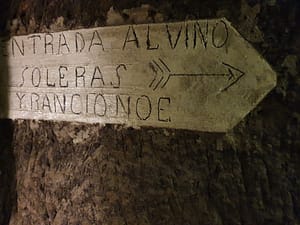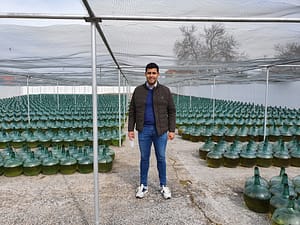We continue our trip back in time. Now we shall visit two more producers of the Catholic Monarchs’ drink.
We arrive at Alberto Gutiérrez, or: De Alberto. The Gutiérrez family has been making this type of wine since the 1940s. Today’s management is 4th generation and has 500 hectares of vineyards. They fill 8,000 damajuanas of 16 liters and up to 6,000 bottles annually. The house is thus the largest producer of dorado.
Export Manager Diego González Hernández meets us. We talk about the production of their dorado while wandering in a labyrinth of underground cellars, formerly a bodega that was part of a 16th century convention and was used for fermentation.
Harvesting takes place at night, as is usual in modern Rueda, usually in late September / first part of October. The grapes are picked when they have a potential 11-13% of alcohol. The first fermentation is exactly like for white wine. Then they add alcohol until the wine has reached 17%, then store it in damajuana for 8-10 months. Thereafter awaits a year in a solera, where the oldest barrels are from the earliest times, ie more than 70 years old. Then follows a year in newer barrels. 10% of the barrels are then bottled. Today, only verdejo is used. But since it is a form of solera, it is still possible that there are drops of palomino in there.
We tasted a pálido, but also their El Dorado. The colour is light amber. In terms of aroma and taste, I can not say that it is fundamentally different from Cachazo’s wine (read first part here); with aroma of nuts, dried fruit and vanilla, glyceric in the mouth and with a concentrated bitterness that perfectly complements the sweetness and the alcohol in the aftertaste.
Cuatro Rayas (Agrícola Castellana)
It was in 1935 that the village doctor in La Seca encouraged several wine-growing families to unite, not only to become bigger, but also stronger. The backdrop was a particularly unstable Spain, which only a year later would prove to break out in civil war. Today, the cooperative has 300 members in 30 municipalities, taps around 15 million bottles annually and has thus become the largest producer in DO Rueda. It is also the largest producer of organic wine. The cooperative changed its name a couple of years ago, from Agrícola Castellana to Cuatro Rayas, after its most famous brand. The bodega name means four stripes, is designed as a musical ‘sharp’ or a hashtag, and symbolizes the four important villages of La Seca, Rueda, Rodilana and Medina del Campo.
In the 1950s, the first commercial brand of the young cooperative was born. The members had decided that the wine should be brought to the large common cellar and poured into large vessels. During the first years, it was said that of all the vats with wine, number 61 was the best of them all. The house brand Fino 61 was named after this vat.
We meet oenologist Roberto L. Tello and Sara Manzanas in the communications department. Roberto and Sara concentrated most on the best wine, 61 Dorado en Rama, but we also tasted the “regular” 61, and the company’s pálido. “En rama” means that the wine does not undergo clarification or filtration. In short, it is based on verdejo and palomino fino; 75% verdejo for the wine 61 en Rama, while the other wine has 50/50, both from old vines. The grapes are harvested by hand in the morning, in late August and the first half of September. Biological fermentation takes place in sherry barrels, where one sixth is not filled, to stimulate the development of flor. The wine is bottled once a year and then refilled with wine matured in a concrete tank for a year. During the autumn and winter, it loses its flor layer, which leads to a gradual oxidative maturation. At Cuatro Rayas, the wine is fortified to 17%. Production is limited to about a thousand bottles.
Flor is a native yeast, which comes naturally. Cuatro Rayas is also collaborating with the University of León to “save” local yeast strains, and then use them in production. In general, work is done organically and with a philosophy of a low climate footprint. When asked about the number of criadeas, Roberto says that here is a solera, a criadera and the rest.
61 Dorado en Rama follows the aforementioned dorado wines in style: Clear, light golden amber color, aroma of pastries, vanilla, pastries, caramel and a toasted tone, honey, caramel and dried fruit. There is a clear difference to the “ordinary” wine, which is not as expressive and where the alcohol is more evident.









